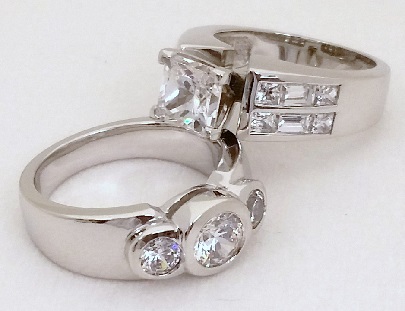As the popularity of white gold fashion jewelry increases, with it emerges two issues that affect today’s consumers. The first issue issue is the usage of rhodium plating as a top coat over the white gold. The second issue is skin allergies caused from nickel alloys used in white gold jewelry. Both issues are inter-related and have generated a huge amount of discussion among the trades and various consumer groups. It is clear that most first time owners of white gold are unaware of these issues and how it may affect them.
Ten Things You Need to Know About Rhodium Plating
1. Is it illegal to use Rhodium plating over white gold jewelry and not advise the buyer about it?
Yes, it is illegal to sell rhodium plated white gold without disclosing it to the customer. JC Penney lost a class action lawsuit regarding this. The best quality jewelry stores will always tell you. Some will even post small consumer signage withing their display case. Often the customer does not hear the sales person’s disclosure due to the excitement of the moment.
2. After years of wear my mother’s white gold wedding band still looks great. Why didn’t hers need constant re-plating like mine has?
Your mothers white gold ring probably used palladium as its only whitening alloy instead of the more common nickel used as an alloy today. Palladium white gold is chemically stable and remains a pleasing warm “gray white” and does not require rhodium plating to remain attractive or to resist discoloration from chemical exposure.
3. I had my white gold ring re-sized and the back of the band has developed small spots on its’ surface. What is going on?
There was a very good chance that the rhodium plating bath was contaminated with some other metal such as silver or iron. They were co-deposited with rhodium. As they oxidize, tiny spots show up on the plated surface. The plating on the ring needs to be removed and re-plated on a clean surface using a fresh plating bath.
4. My white gold ring needs re-plating with rhodium about every six months. How can I make it last longer?
You need to have it plated with an adequate layer of rhodium. A minimum 30-40 micro-inches of uniform rhodium plating would provide excellent durability and would help eliminate so many frequent trips to the jewelry store. Some store will send their jewelry out to specialty plating shops who can provide the heavier coatings.
5. I just replaced my nickel white gold ring with a new palladium white gold ring and yet I am still getting a skin rash. Why is this happening?
It would appear that your new ring also contains nickel. It is quite common to combine nickel with palladium as a bleaching agent for white gold. In general, a good balance is achieved between color and workability of the metal. Be aware, it could be a palladium-nickel alloy because palladium by itself will not cause a skin rash.
6. Is it true that perfume can make rhodium wear off?
There is no doubt that exposure to chemicals can play a role in the diminished life of rhodium plating. Having said that there is much that can be done to minimize the effects of incidental contact with perfumes, soaps and chlorine. It starts with a thick, pore-free layer of rhodium applied over a clean surface using the correct methods.
7. I want to have a yellow gold chain re-plated. How thick should the rhodium be and how long can I expect it to last?
Chains have to survive in an environment of perspiration, cologne, and constant soft abrasion of the links itching together as part of the normal movement of the human body. Worn 24/7, they present one of the most significant challenges for a plated coating. You need at least 40 micro-inches of uniform rhodium. The durability is 1-3 years.
8. Why did my silver jewelry tarnish after being plated with rhodium?
The rhodium layer is probably too thin! The discoloring is due to the corrosive oxides that are “rising” through the microscopic pores within the rhodium plated surface. This type of surface tarnish will eventually appear “yellowish” bright to the observer and is commonly noticed on jewelry items such as chains and bracelets.
9. The plating on my fiancee’s engagement ring wore off after 4 months. Why did it wear off so quickly?
If the ring was re-sized, than probably the repair area was not properly cleaned prior to re-plating or there just was not a thick enough layer of rhodium applied for adequate long term wear life. If the ring was created from a casting and not die struck, there could be porosity in the setting that caused the rhodium to wear off too soon.
10. Help! I’ve developed a skin rash from my white gold ring.
There is a solution. If you apply a thick layer of dense, pore-free rhodium plating over the entire contact surface of the ring—including inside the contours—nickel rashes can be virtually eliminated. The rhodium coating must thick because any breach in the rhodium layer can cause re-exposure to the nickel in your white gold.
Do you need Rhodium plating? Contact us. Artisan Plating are the Rhodium experts.


